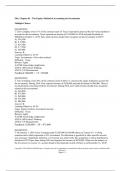File: Chapter 01 - The Equity Method of Accounting for Investments
Multiple Choice:
[QUESTION]
1. Gaw Company owns 15% of the common stock of Trace Corporation and used the fair-value method to
account for this investment. Trace reported net income of $110,000 for 2018 and paid dividends of
$60,000 on October 1, 2018. How much income should Gaw recognize on this investment in 2018?
A) $16,500.
B) $ 9,000.
C) $25,500.
D) $ 7,500.
E) $50,000.
Answer: B
Learning Objective: 01-01
Topic: Investments―Fair-value method
Difficulty: 1 Easy
Blooms: Apply
AACSB: Knowledge Application
AICPA: BB Critical Thinking
AICPA: FN Measurement
Feedback: $60,000 × .15 = $9,000
[QUESTION]
2. Yaro Company owns 30% of the common stock of Dew Co. and uses the equity method to account for
the investment. During 2018, Dew reported income of $250,000 and paid dividends of $80,000. There is
no amortization associated with the investment. During 2018, how much income should Yaro recognize
related to this investment?
A) $24,000.
B) $75,000.
C) $99,000.
D) $51,000.
E) $80,000.
Answer: B
Learning Objective: 01-03
Topic: Equity method―Investment income
Difficulty: 1 Easy
Blooms: Apply
AACSB: Knowledge Application
AICPA: BB Critical Thinking
AICPA: FN Measurement
Feedback: $250,000 × .30 = $75,000
[QUESTION]
3. On January 1, 2018, Pacer Company paid $1,920,000 for 60,000 shares of Lennon Co.’s voting
common stock which represents a 45% investment. No allocation to goodwill or other specific account
was necessary. Significant influence over Lennon was achieved by this acquisition. Lennon distributed a
dividend of $2.50 per share during 2018 and reported net income of $670,000. What was the balance in
the Investment in Lennon Co. account found in the financial records of Pacer as of December 31, 2018?
Copyright © 2018 McGraw-Hill Education. All rights reserved. No reproduction or distribution without the prior written consent of McGraw-Hill
Education.
Page 1-1
,A) $2,040,500.
B) $2,212,500.
C) $2,260,500.
D) $2,171,500.
E) $2,071,500.
Answer: E
Learning Objective: 01-03
Topic: Equity method―Investment account balance
Difficulty: 2 Medium
Blooms: Apply
AACSB: Knowledge Application
AICPA: BB Critical Thinking
AICPA: FN Measurement
Feedback: $1,920,000 + ($670,000 × .45) – ($2.50 × 60,000) = $2,071,500
[QUESTION]
4. An investor should always use the equity method to account for an investment if:
A) It has the ability to exercise significant influence over the operating policies of the investee.
B) It owns 30% of an investee’s stock.
C) It has a controlling interest (more than 50%) of an investee’s stock.
D) The investment was made primarily to earn a return on excess cash.
E) It does not have the ability to exercise significant influence over the operating policies of the investee.
Answer: A
Learning Objective: 01-02
Topic: Equity method―Significant influence criterion
Difficulty: 1 Easy
Blooms: Remember
AACSB: Reflective Thinking
AICPA: BB Critical Thinking
AICPA: FN Measurement
[QUESTION]
5. On January 1, 2016, Dermot Company purchased 15% of the voting common stock of Horne Corp. On
January 1, 2018, Dermot purchased 28% of Horne’s voting common stock. If Dermot achieves significant
influence with this new investment, how must Dermot account for the change to the equity method?
A) It must use the equity method for 2018 but should make no changes in its financial statements for 2017
and 2016.
B) It should prepare consolidated financial statements for 2018.
C) It must restate the financial statements for 2017 and 2016 as if the equity method had been used for
those two years.
D) It should record a prior period adjustment at the beginning of 2018 but should not restate the financial
statements for 2017 and 2016.
E) It must restate the financial statements for 2017 as if the equity method had been used then.
Answer: A
Learning Objective: 01-05a
Topic: Report change to equity method
Difficulty: 2 Medium
Blooms: Understand
AACSB: Analytical Thinking
AICPA: BB Critical Thinking
Copyright © 2018 McGraw-Hill Education. All rights reserved. No reproduction or distribution without the prior written consent of McGraw-Hill
Education.
Page 1-2
,AICPA: FN Measurement
[QUESTION]
6. During January 2017, Wells, Inc. acquired 30% of the outstanding common stock of Wilton Co. for
$1,400,000. This investment gave Wells the ability to exercise significant influence over Wilton. Wilton’s
assets on that date were recorded at $6,400,000 with liabilities of $3,000,000. Any excess of cost over
book value of Wells’ investment was attributed to unrecorded patents having a remaining useful life of
ten years.
In 2017, Wilton reported net income of $600,000. For 2018, Wilton reported net income of $750,000.
Dividends of $200,000 were paid in each of these two years. What was the reported balance of Wells’
Investment in Wilson Co. at December 31, 2018?
A) $1,609,000.
B) $1,485,000.
C) $1,685,000.
D) $1,647,000.
E) $1,054,300.
Answer: A
Learning Objective: 01-04
Topic: Equity method―Investment account balance
Difficulty: 3 Hard
Blooms: Apply
AACSB: Knowledge Application
AICPA: BB Critical Thinking
AICPA: FN Measurement
Feedback: $6,400,000 - $3,000,000 = $3,400,000 × 30% = $1,020,000
$1,400,000 - $1,020,000 = $380,yrs = $38,000 Unrecorded Patents Amortization
$1,400,000 + $180,000 + $225,000 - $60,000 - $60,000 - $38,000 - $38,000 = $1,609,000
[QUESTION]
7. On January 1, 2018, Bangle Company purchased 30% of the voting common stock of Sleat Corp. for
$1,000,000. Any excess of cost over book value was assigned to goodwill. During 2018, Sleat paid
dividends of $24,000 and reported a net loss of $140,000. What is the balance in the investment account
on December 31, 2018?
A) $950,800.
B) $958,000.
C) $836,000.
D) $990,100.
E) $956,400.
Answer: A
Learning Objective: 01-03
Learning Objective: 01-05c
Topic: Equity method―Investment account balance
Topic: Report investee losses
Difficulty: 2 Medium
Blooms: Apply
AACSB: Knowledge Application
AICPA: BB Critical Thinking
AICPA: FN Measurement
Feedback: $1,000,000 - $42,000 - $7,200 = $950,800
Copyright © 2018 McGraw-Hill Education. All rights reserved. No reproduction or distribution without the prior written consent of McGraw-Hill
Education.
Page 1-3
, [QUESTION]
8. On January 1, 2018, Jordan Inc. acquired 30% of Nico Corp. Jordan used the equity method to account
for the investment. On January 1, 2019, Jordan sold two-thirds of its investment in Nico. It no longer had
the ability to exercise significant influence over the operations of Nico. How should Jordan account for
this change?
A) Jordan should continue to use the equity method to maintain consistency in its financial statements.
B) Jordan should restate the prior years’ financial statements and change the balance in the investment
account as if the fair-value method had been used since 2018.
C) Jordan has the option of using either the equity method or the fair-value method for 2018 and future
years.
D) Jordan should report the effect of the change from the equity to the fair-value method as a
retrospective change in accounting principle.
E) Jordan should use the fair-value method for 2019 and future years, but should not make a retrospective
adjustment to the investment account.
Answer: E
Learning Objective: 01-05d
Topic: Report sale of equity investment
Difficulty: 2 Medium
Blooms: Understand
AACSB: Reflective Thinking
AICPA: BB Critical Thinking
AICPA: FN Measurement
[QUESTION]
9. Tower Inc. owns 30% of Yale Co. and applies the equity method. During the current year, Tower
bought inventory costing $66,000 and then sold it to Yale for $120,000. At year-end, only $24,000 of
merchandise was still being held by Yale. What amount of intra-entity gross profit must be deferred by
Tower?
A) $ 6,480.
B) $ 3,240.
C) $10,800.
D) $16,200.
E) $ 6,610.
Answer: B
Learning Objective: 01-06
Topic: Intra–entity sales of inventory
Difficulty: 2 Medium
Blooms: Apply
AACSB: Knowledge Application
AICPA: BB Critical Thinking
AICPA: FN Measurement
Feedback: $120,000 - $66,000 = $54,000
$24,000 / $120,000 = 20% × $54,000 = $10,800 × 30% = $3,240
[QUESTION]
10. On January 4, 2018, Watts Co. purchased 40,000 shares (40%) of the common stock of Adams Corp.,
paying $800,000. There was no goodwill or other cost allocation associated with the investment. Watts
has significant influence over Adams. During 2018, Adams reported income of $200,000 and paid
dividends of $80,000. On January 2, 2019, Watts sold 5,000 shares for $125,000. What was the balance in
the investment account after the shares had been sold?
Copyright © 2018 McGraw-Hill Education. All rights reserved. No reproduction or distribution without the prior written consent of McGraw-Hill
Education.
Page 1-4





